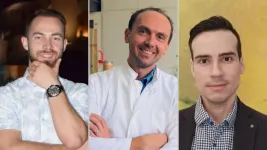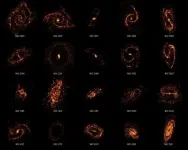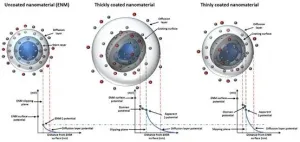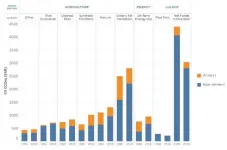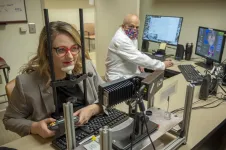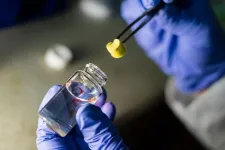Scientists develop the 'evotype' to unlock power of evolution for better engineering biology
2021-06-08
(Press-News.org) A defining characteristic of all life is its ability to evolve. However, the fact that biologically engineered systems will evolve when used has, to date, mostly been ignored. This has resulted in biotechnologies with a limited functional shelf-life that fail to make use of the powerful evolutionary capabilities inherent to all biology.
Sim Castle, first author of the research, published in Nature Communications, and a PhD student in the School of Biological Sciences at Bristol, explained the motivation for the work: "The thing that has always fascinated me about biology is that it changes, it is chaotic, it adapts, it evolves. Bioengineers therefore do not just design static artefacts - they design living populations that continue to mutate, grow and undergo natural selection."
Realising that describing this change was key to harnessing evolution, the team developed the concept of the evotype to capture the evolutionary potential of a biosystem. Crucially, the evotype can be broken into three key parts: variation, function, and selection, with each of these offering a tuning knob for bioengineers to control the possible paths available to evolution.
Prof Claire Grierson, co-author and Head of the School of Biological Sciences at Bristol, added: "Learning how to effectively engineer with evolution is one of, if not the biggest, challenges facing bioengineers today. Our work provides a desperately needed framework to help describe the evolutionary potential of a biosystem and re-imagine biological engineering so that it works in harmony with life's ability to evolve."
Sim Castle further stated: "What was surprising was that many of the tools already available to bioengineers fitted nicely into our framework when considered from an evolutionary perspective. We therefore might not be too far from making evolution a core feature of future engineered biological systems."
Dr Thomas Gorochowski, senior author and a Royal Society University Research Fellow at Bristol, ended by saying: "Our concept of the evotype not only provides a means for developing biotechnologies that can harness evolution in new ways, but also opens exciting new avenues to think about and implement evolution in completely new contexts. Potentially, this could even lead to us designing new, self-adaptive technologies that evolve from scratch, rather than tinkering with biological ones that already do."
INFORMATION:
This work was funded by the Royal Society, BBSRC/EPSRC Bristol Centre for Synthetic Biology (BrisSynBio) and EPSRC/BBSRC Synthetic Biology Centre for Doctoral Training (SynBioCDT) with support from the Bristol BioDesign Institute (BBI).
Paper
Simeon D. Castle, Claire S. Grierson, Thomas E. Gorochowski. Towards an engineering theory of evolution. Nature Communications, 2021; https://www.nature.com/articles/s41467-021-23573-3
[Attachments] See images for this press release:

ELSE PRESS RELEASES FROM THIS DATE:
2021-06-08
The presence of amino acids on the prebiotic Earth is widely accepted, either coming from endogenous chemical processes or being delivered by extraterrestrial material. On the other hand, plausibly prebiotic pathways to peptides often rely on different aqueous approaches where condensation of amino acids is thermodynamically unfavorable. Now, chemists from the Ruđer Bošković Institute (RBI), in collaboration with colleagues from Xellia Pharmaceuticals, have shown that solid-state mechanochemical activation of glycine and alanine in combination with mineral surfaces leads to the formation of peptides. ...
2021-06-08
A team of astronomers using the Atacama Large Millimeter/submillimeter Array (ALMA) has completed the first census of molecular clouds in the nearby Universe, revealing that contrary to previous scientific opinion, these stellar nurseries do not all look and act the same. In fact, they're as diverse as the people, homes, neighborhoods, and regions that make up our own world.
Stars are formed out of clouds of dust and gas called molecular clouds, or stellar nurseries. Each stellar nursery in the Universe can form thousands or even tens of thousands of new stars during its lifetime. Between 2013 and 2019, astronomers on the PHANGS-- Physics at High Angular Resolution in Nearby GalaxieS-- project conducted the first systematic survey of 100,000 stellar nurseries ...
2021-06-08
COLUMBUS, Ohio - Astronomers have taken a big step forward in understanding the dark and violent places where stars are born.
Over the past five years, an international team of researchers has conducted the first systematic survey of "stellar nurseries" across our part of the universe, charting the more than 100,000 of these nurseries across more than 90 nearby galaxies and providing new insights into the origins of stars.
"Every star in the sky, including our own sun, was born in one of these stellar nurseries," said Adam Leroy, associate professor of astronomy at The Ohio State University and one of ...
2021-06-08
Researchers from the University of Arizona will present findings from radio-astronomical observations of organic molecules at the 238th Meeting of the American Astronomical Society, or AAS, during a press conference titled "Molecules in Strange Places" at the 238th AAS Meeting on Tuesday, June 8, at 12:15 p.m. EDT.
A team led by Lucy Ziurys at the University of Arizona reports observations of organic molecules in planetary nebulae in unprecedented detail and spatial resolution. Using the Atacama Large Millimeter Array, or ALMA, Ziurys and her team observed radio emissions from hydrogen cyanide (HCN), formyl ion (HCO+) and carbon monoxide (CO) in five planetary nebulae: M2-48, M1-7, M3-28, K3-45 and K3-58.
The ...
2021-06-08
Researchers have developed a 'library of properties' to help identify the environmental impact of nanomaterials faster and more cost effectively.
Whilst nanomaterials have benefited a wide range of industries and revolutionised everyday life, there are concerns over potential adverse effects - including toxic effects following accumulation in different organs and indirect effects from transport of co-pollutants.
The European Union H2020-funded NanoSolveIT project is developing a ground-breaking computer-based Integrated Approach to Testing and Assessment (IATA) for the environmental health and safety of nanomaterials.
Over ...
2021-06-08
A new global analysis says that greenhouse-gas emissions from food systems have long been systematically underestimated--and points to major opportunities to cut them. The authors estimate that activities connected to food production and consumption produced the equivalent of 16 billion metric tons of carbon dioxide in 2018--one third of the human-produced total, and an 8 percent increase since 1990. A companion policy paper highlights the need to integrate research with efforts to reduce emissions. The papers, developed jointly by the UN Food and Agriculture Organization, NASA, New York University and experts at Columbia University, are part of a special issue of Environmental Research Letters on sustainable food systems.
The Center on Global Energy ...
2021-06-08
Stereotypes are knowledge structures integrated in our world representation, which have an influence on our decisions and which are hard to change. A team from the Faculty of Psychology of the University of Barcelona (UB) and the Bellvitge Biomedical Research Institute (IDIBELL), in collaboration with the Èpica Foundation - La Fura dels Baus analysed how a performing experience could have a positive impact in reducing the population's bias against physical illnesses. This performing experience is a pioneer one for it combines scientific training and theatre performance in the same working platform.
The study, published in the journal Frontiers in Psychology, shows that the participation ...
2021-06-08
After looking for just one-twentieth of a second, experts in camouflage breaking can accurately detect not only that something is hidden in a scene, but precisely identify the camouflaged target, a skill set that can mean the difference between life and death in warfare and the wild, investigators report.
They can actually identify a camouflaged target as fast and as well as individuals identifying far more obvious "pop-out" targets, similar to the concept used at a shooting range, but in this case using easy-to-spot scenarios like a black O-shaped target among a crowd of black C shapes.
In fact, the relatively rapid method for training civilian novices to become expert camouflage breakers developed by Medical College of Georgia neuroscientist ...
2021-06-08
Medics training to be GPs reported positive improvement in burnout and resilience after completing a mindfulness course specially designed for doctors
The participants in the study by Warwick Medical School also saw improvements in their wellbeing and stress
By improving the mental wellbeing of trainees the researchers hope to better prepare them for the challenges of general practice and the impact of Covid-19 on the profession
Supports the wider adoption of mindfulness in medical training and the need for larger studies
Medics training to become general practitioners reported a significant positive improvement in their mental wellbeing after participating in a specially-designed mindfulness programme, a study from University of Warwick researchers ...
2021-06-08
HOUSTON - (June 8, 2021) - A simple chemical process developed at Rice University creates light and highly absorbent aerogels that can take a beating.
Covalent organic frameworks (COFs), crystal structures with strong molecular bonds, can form a porous aerogel for use as a custom membrane in batteries or other devices or as an absorbent to remove pollutants from the environment.
Conventional COFs are usually powders. Chemical and biomolecular engineer Rafael Verduzco, lead authors and Rice graduate students Dongyang Zhu and Yifan Zhu and their colleagues at Rice's Brown School of Engineering discovered a way to synthesize COF aerogels that can be made in any form ...
LAST 30 PRESS RELEASES:
[Press-News.org] Scientists develop the 'evotype' to unlock power of evolution for better engineering biology

